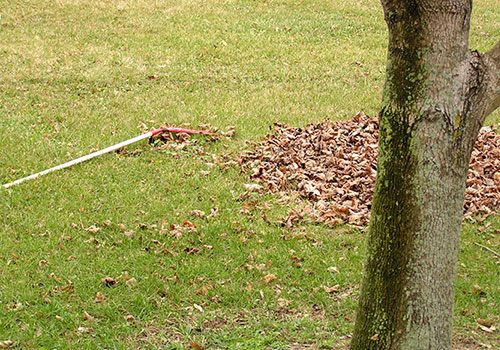
Rake -- or mow -- leaves from your lawn to keep it healthy through the winter.
Clearing leaves helps home lawns, may provide compost for garden
Whether by rake or by mower, work should be done soon
Oct. 29, 2020
MANHATTAN, Kan. –
In case you are dreading the thought of pulling out a rake to gather piles of leaves that have fallen on your lawn, Ward Upham has an important message: It’s worth the effort.
“A scattering of leaves won’t harm the lawn,” said Upham, a horticulture expert at Kansas State University, “but excessive cover prevents sunlight from reaching the plants, which means the lawn will be unable to make the carbohydrates needed to carry it through winter.”
The work does not need to be labor-intensive. Instead of a rake, many homeowners have gone to using a mower with a bag attached, which chops and collects the leaves and opens the opportunity to use the litter as compost.
“That compost can then be used for vegetable gardens or annual flower beds,” Upham said. “Transport them to the garden or bed and apply a 2- to 3-inch layer of leaves on the surface of the soil, then till them in. Repeat the process every couple of weeks until you run out of leaves, the weather becomes too cold, or the soil becomes too wet.
“With luck, you should be able to make three to four applications this fall.”
Another option is to mow the leaves with a mulching mower and let shredded leaves filter into the turf’s canopy. Upham notes that a side-discharge mower may work, though it typically does not shred the leaves as thoroughly.
“Mulching leaves is most effective if you do it often enough that leaf litter doesn’t become too thick,” he said. “Mow while you can still see grass peaking through the leaves.”
The process, Upham added, is supported by a study from Michigan State University in which researchers used a mulching mower for five consecutive years and found no long-term effects of the shredded leaves on turf quality, thatch thickness, organic content or soil test results.
“If you mow leaves and have a cool-season lawn, it makes sense to be on a fall nitrogen fertilization program and core aerate in the fall – things you should be doing anyway,” Upham said. “If you have a warm-season lawn, you can still use this technique, but wait until next May or early June to fertilize and aerate.”
Upham and his colleagues in K-State’s Department of Horticulture and Natural Resources produce a weekly Horticulture Newsletter with tips for maintaining home landscapes. The newsletter is available to view online or can be delivered by email each week.
Interested persons can also send their garden- and yard-related questions to Upham at wupham@ksu.edu, or contact your local K-State Research and Extension office.

